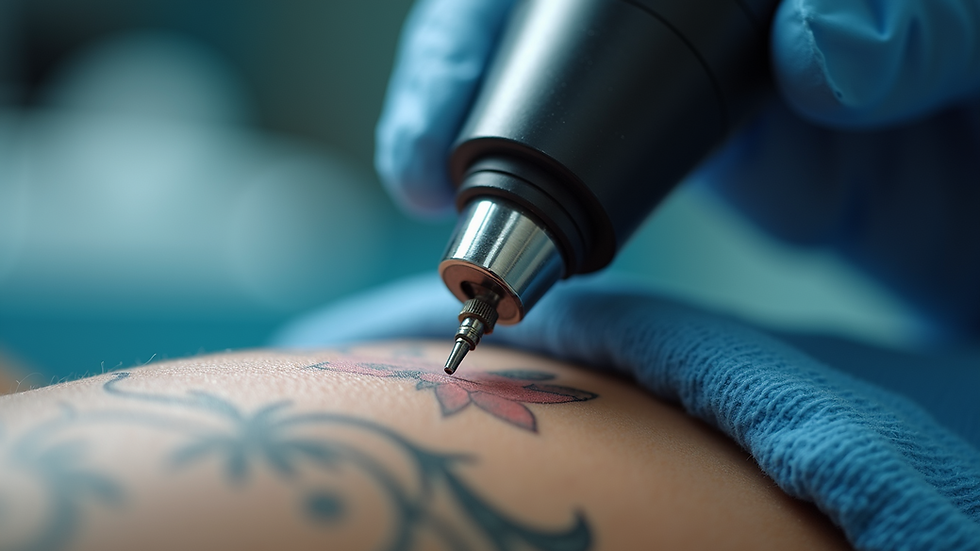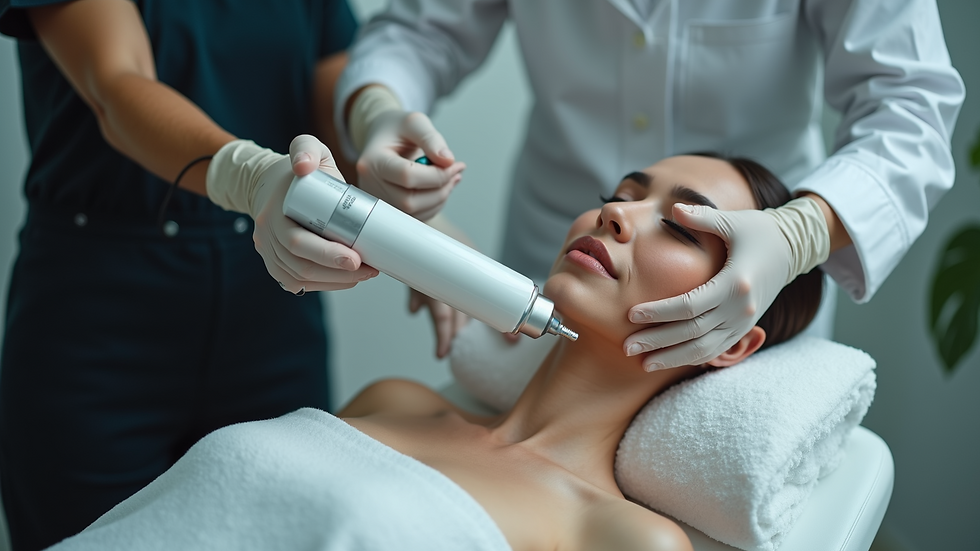Effective Laser Tattoo Removal in London
- Anan

- Aug 6
- 5 min read
Tattoo removal has become an increasingly sought-after service as more individuals reconsider their body art choices. The evolution of laser technology has made this process safer, more efficient, and accessible than ever before. In London, where aesthetic treatments are in high demand, understanding the laser tattoo removal process is essential for those seeking to erase unwanted ink or for practitioners aiming to offer superior services. This article delves into the intricacies of laser tattoo removal, highlighting the technology, procedure, and factors influencing success.

Close-up view of laser device head used for tattoo removal
Understanding the Laser Tattoo Removal Process
The laser tattoo removal process involves the use of highly concentrated light beams to break down tattoo pigments beneath the skin. Unlike traditional methods such as dermabrasion or surgical excision, laser removal targets the ink particles without causing significant damage to surrounding tissue. This precision is achieved through selective photothermolysis, where specific wavelengths of light are absorbed by tattoo pigments, fragmenting them into smaller particles.
These fragmented particles are then naturally eliminated by the body's immune system over time. The number of sessions required varies depending on several factors, including tattoo size, ink colours, depth, and skin type. Typically, patients undergo between six to twelve sessions spaced six to eight weeks apart to allow adequate healing and pigment clearance.
The procedure is performed by trained professionals using advanced laser systems such as Q-switched Nd:YAG lasers, which emit pulses in nanoseconds. These lasers are capable of targeting multiple ink colours, including black, blue, green, and red, with varying wavelengths tailored to each pigment.
Key Factors Influencing Laser Tattoo Removal Success
Several critical factors determine the effectiveness and safety of the laser tattoo removal process. Understanding these elements helps set realistic expectations and guides treatment planning.
Tattoo Age and Ink Composition: Older tattoos tend to fade naturally and respond better to laser treatment. Professional tattoos with dense, high-quality ink may require more sessions compared to amateur or homemade tattoos.
Ink Colours: Black ink absorbs all laser wavelengths and is the easiest to remove. Colours like green and yellow are more challenging due to their light absorption properties and may need specialized lasers.
Skin Type and Tone: Darker skin tones require careful laser selection and settings to avoid pigmentation changes or burns. Practitioners must adjust parameters to ensure safety and efficacy.
Location on the Body: Areas with better blood circulation, such as the face and neck, often heal faster and show quicker pigment clearance than extremities like hands or feet.
Patient Health and Immune Response: A robust immune system accelerates the removal of ink particles. Patients are advised to maintain good health and avoid smoking to enhance results.

Eye-level view of laser treatment room with modern equipment
The Step-by-Step Procedure of Laser Tattoo Removal
The laser tattoo removal process is methodical and requires professional expertise to ensure optimal outcomes. Below is a detailed overview of what patients can expect during treatment.
Initial Consultation and Assessment
The process begins with a thorough consultation where the practitioner evaluates the tattoo, skin type, and medical history. This step is crucial for determining the appropriate laser type and treatment plan.
Preparation
On the day of treatment, the area is cleaned and sometimes numbed with a topical anaesthetic to minimise discomfort. Protective eyewear is provided to shield both patient and practitioner from laser exposure.
Laser Application
The laser device is calibrated to the specific settings required for the tattoo’s ink colours and skin type. Pulses of laser light are delivered to the tattooed area, producing a snapping or popping sensation. The duration depends on the tattoo size.
Post-Treatment Care
After the session, the treated area may appear red, swollen, or blistered. Cooling packs and soothing ointments are applied to reduce inflammation. Patients receive detailed aftercare instructions to prevent infection and promote healing.
Follow-Up Sessions
Multiple sessions are scheduled at intervals of six to eight weeks. This spacing allows the skin to recover and the immune system to clear fragmented ink particles effectively.
Safety Considerations and Potential Side Effects
Laser tattoo removal is generally safe when performed by qualified professionals using FDA-approved equipment. However, understanding potential risks and side effects is essential for informed decision-making.
Common Side Effects: Temporary redness, swelling, blistering, and mild discomfort are typical immediately after treatment. These symptoms usually resolve within a few days.
Pigmentation Changes: Hypopigmentation (lightening) or hyperpigmentation (darkening) of the skin can occur, especially in individuals with darker skin tones. These changes are often temporary but can be permanent in rare cases.
Scarring: Although uncommon with modern lasers, improper technique or inadequate aftercare can lead to scarring.
Infection: Maintaining hygiene and following aftercare instructions are vital to prevent infections.
Practitioners must conduct a comprehensive risk assessment and provide clear guidance to patients. Pre-treatment patch tests can help identify adverse reactions before full sessions commence.

High angle view of laser tattoo removal aftercare products
Choosing the Right Clinic for Laser Tattoo Removal in London
Selecting a reputable clinic is paramount to achieving successful laser tattoo removal results. London offers numerous options, but not all provide the same level of expertise or technology. When choosing a clinic, consider the following:
Qualified Practitioners: Ensure the clinic employs certified and experienced laser technicians or medical professionals.
Advanced Laser Technology: Clinics using the latest Q-switched or picosecond lasers offer superior results with fewer sessions.
Comprehensive Consultations: A thorough initial assessment and personalised treatment plan demonstrate professionalism and care.
Positive Reviews and Testimonials: Client feedback provides insight into the clinic’s reputation and service quality.
Aftercare Support: Effective post-treatment care and follow-up enhance healing and satisfaction.
For those seeking expert services, laser tattoo removal london at The VA Aesthetics represents a premier choice. Their commitment to cutting-edge technology and patient-centred care ensures outstanding outcomes.
Advancing Careers with Laser Tattoo Removal Training
Beyond treatment, the demand for skilled practitioners in laser tattoo removal continues to grow. Aspiring and current aesthetic professionals can benefit from comprehensive, regulated training programmes that cover theory, practical skills, and safety protocols.
Training courses typically include:
Laser Physics and Skin Anatomy
Types of Lasers and Their Applications
Patient Assessment and Contraindications
Hands-On Laser Operation and Techniques
Managing Complications and Aftercare
Such education equips practitioners to deliver safe, effective treatments and expand their service offerings. The VA Aesthetics provides industry-leading training designed to elevate careers and meet the highest standards in the beauty industry.
Embracing the Future of Tattoo Removal
The field of laser tattoo removal is continuously evolving, with innovations such as picosecond lasers offering faster, more efficient pigment breakdown and reduced side effects. As technology advances, patients and practitioners alike can expect improved experiences and results.
Staying informed about the latest developments and choosing reputable providers ensures that tattoo removal remains a safe, accessible option for those seeking change. Whether erasing a past decision or enhancing professional skills, the laser tattoo removal process in London stands as a testament to modern aesthetic excellence.







Comments